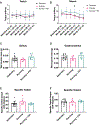Voluntary wheel running with and without follistatin overexpression improves NMJ transmission but not motor unit loss in late life of C57BL/6J mice
- PMID: 33678425
- PMCID: PMC8122043
- DOI: 10.1016/j.neurobiolaging.2021.01.012
Voluntary wheel running with and without follistatin overexpression improves NMJ transmission but not motor unit loss in late life of C57BL/6J mice
Abstract
Sarcopenia, or pathological loss of muscle mass and strength during aging, is an important contributor to loss of physical function in older adults. Sarcopenia is a multifactorial syndrome associated with intrinsic muscle and upstream neurological dysfunction. Exercise is well-established as an effective intervention for sarcopenia, but less is known about the long-term neurobiological impact of exercise. The goals of this study were to investigate the effects of exercise, alone or in combination with follistatin (FST) overexpression (antagonist of myostatin), on neuromuscular junction transmission and motor unit numbers in mice between the age of 22 and 27 months, ages at which prior studies have demonstrated that some motor unit loss is already evident. C57BL/6J mice underwent baseline assessment and were randomized to housing with or without voluntary running wheels and injection with adeno-associated virus to overexpress FST or vehicle. Groups for comparison included sedentary and running with and without FST. Longitudinal assessments showed significantly increased muscle mass and contractility in the 'running plus FST' group, but running, with and without FST, showed no effect on motor unit degeneration. In contrast, running, with and without FST, demonstrated marked improvement of neuromuscular junction transmission stability.
Keywords: Aging; Exercise; Follistatin; Motor Unit; Neuromuscular Junction.
Copyright © 2021. Published by Elsevier Inc.
Conflict of interest statement
Declarations of Competing Interest The authors have no conflicts of interests to report.
Figures







References
-
- Amthor H, Macharia R, Navarrete R, Schuelke M, Brown SC, Otto A, Voit T, Muntoni F, Vrbóva G, Partridge T, Zammit P, Bunger L, Patel K, 2007. Lack of myostatin results in excessive muscle growth but impaired force generation. Proceedings of the National Academy of Sciences 104(6), 1835–1840. - PMC - PubMed
-
- Arnold WD, Clark BC, 2019. Faster, higher, farther: outpacing age-related motor neuron losses. Journal of Physiology-London 597(19), 4867–4868. - PubMed
-
- Ashton-Miller JA, He Y, Kadhiresan VA, McCubbrey DA, Faulkner JA, 1992. An apparatus to measure in vivo biomechanical behavior of dorsi- and plantarflexors of mouse ankle. J Appl Physiol (1985) 72(3), 1205–1211. - PubMed
Publication types
MeSH terms
Substances
Grants and funding
LinkOut - more resources
Full Text Sources
Other Literature Sources
Medical
Miscellaneous

